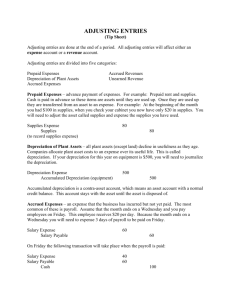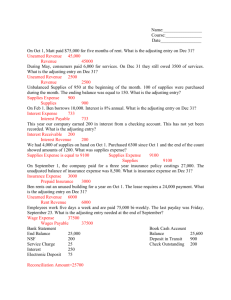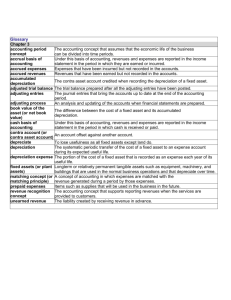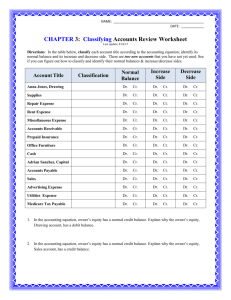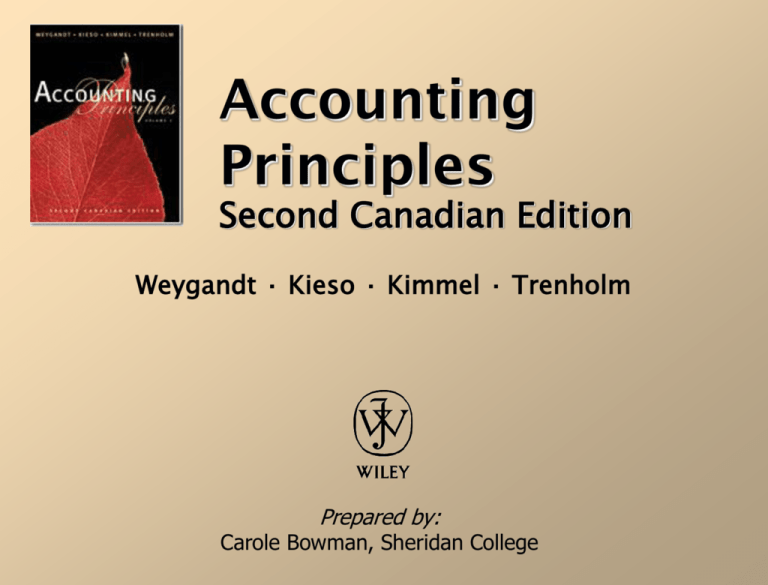
Accounting
Principles
Second Canadian Edition
Weygandt · Kieso · Kimmel · Trenholm
Prepared by:
Carole Bowman, Sheridan College
CHAPTER
3
ADJUSTING THE ACCOUNTS
GAAP Principals
(Time period assumption, Revenue Recognition, Matching Principal,
Accrual Basis of Accounting)
Types of Adjusting Entries
(Prepaid Expenses such as rent, insurance, and supplies, unearned
revenue, accrued revenues and expenses, and amortization/depreciation)
STEPS IN THE ACCOUNTING CYCLE
1. Analyse
transactions
9. Coming
next chapter
2. Journalize the
transactions
3. Post to ledger
accounts
8. Coming
next chapter
7. Prepare
financial
statements
4. Prepare a
trial balance
6. Prepare
adjusted trial
balance
5. Journalize
and post
adjusting
entries
GAAP
TIME PERIOD ASSUMPTION
The time period (or periodicity) assumption assumes that
the economic life of a business can be divided into artificial
time periods — generally a month, a quarter (3 months),
or a year (any 12 month period selected by the company).
Periods of less than one year are called interim periods.
The accounting time period of one year in
usually known as a fiscal year.
length is
GAAP
REVENUE RECOGNITION PRINCIPLE
The revenue recognition principle states that revenue
should be recognized in the accounting period in which it
is earned.
In a service business, revenue is usually considered to be
earned at the time the service is performed, even if the
money has not been received.
Example: Crocco Co. performed legal services and
billed customer, Mr. Nojail, for $350.00
A/R
Legal Fees
$350.00
$350.00
In a merchandising business, revenue is usually earned at
the time the goods are delivered.
GAAP
THE MATCHING PRINCIPLE
The practice of expense recognition is referred to as the matching
principle.
The matching principle dictates that efforts (expenses) be matched with
accomplishments (revenues).
Example: For a fiscal year ending, December 31st, the last week of wages in
December for the year, must be expensed even though they are not paid
out until the end of the first week in January. These wages pertain to
revenues earned right up to the end of December. Wages for the last
week of December amounted to $1000, but are not paid out until the end
of the first week of January.
Salaries Expense
$1000
Salaries Payable
Revenues
earned
this month
$1000
are offset
against....
expenses
incurred in
earning the
revenue
ACCRUAL BASIS OF
ACCOUNTING
Adheres to the:
Revenue recognition principle
Matching principle
Revenue recorded when earned, not only when
cash received.
Expense recorded when services or goods are
used or consumed in the generation of revenue,
not only when cash paid. (i.e. Salaries Expense
and Salaries Payable)
CASH BASIS OF
ACCOUNTING
Revenue
recorded
only when cash
received.
Expense
recorded
only when cash
paid.
PURPOSE OF
ADJUSTING ENTRIES
Adjusting entries make the revenue
recognition and matching principles
HAPPEN!
ILLUSTRATION 3-3
TRIAL BALANCE
Pioneer Advertising Agency
Trial Balance
October 31, 2002
Cash
Advertising Supplies
Prepaid Insurance
Office Equipment
Notes Payable
Accounts Payable
Unearned Revenue
C.R. Byrd, Capital
C.R. Byrd, Drawings
Service Revenue
Salaries Expense
Rent Expense
The Trial Balance
is analysed to
determine the
need for adjusting
entries.
Debit
$ 15,200
2,500
600
5,000
Credit
$ 5,000
2,500
1,200
10,000
500
10,000
4,000
900
$ 28,700
$ 28,700
ADJUSTING ENTRIES
Adjusting entries are required each time
financial statements are prepared.
Adjusting entries can be classified as
1. prepayments (prepaid expenses or
unearned revenues),
2. accruals (accrued revenues or
accrued expenses), or
3. estimates (amortization/depreciation).
TYPES OF ADJUSTING ENTRIES
Prepayments
1. Prepaid Expenses — Expenses paid in cash
and recorded as assets before they are used or
consumed. (i.e. Prepaid Insurance)
2. Unearned Revenues — Revenues received in
cash and recorded as liabilities before they
are earned. (i.e. Unearned Revenue)
TYPES OF ADJUSTING ENTRIES
Accruals
1. Accrued Revenues — Revenues earned but
not yet received in cash or recorded. (i.e.
Accounts Receivable)
2. Accrued Expenses — Expenses incurred but
not yet paid in cash or recorded. (i.e. Salaries
Payable, Interest Payable)
TYPES OF ADJUSTING ENTRIES
Estimates
1. Amortization — Allocation of the cost of
capital assets/fixed assets to expense over their
useful lives.
Amortization will replace the term Depreciation.
PREPAID EXPENSES
Prepaid expenses are expenses paid in cash and recorded as assets before
they are used or consumed. (i.e. insurance, rent)
Jan.1
Banks Co. paid 3 months rent upfront for $3000 cash.
Jan. 1
Prepaid Rent $3000
Cash
$3000
Prepaid expenses expire with the passage of time or through use and
consumption. The adjusting entry Jan. 30 in order to prepare monthly
financial statements would be:
Jan. 30 Banks Co. made monthly adjustments to prepare monthly financial
statements.
Jan. 30
Rent Expense
$1000
Prepaid Rent
$1000
An asset-expense account relationship exists with prepaid expenses.
PREPAID EXPENSES
Prior to adjustment, assets are overstated and
expenses are understated.
The adjusting entry results in a debit to an
expense account and a credit to an asset
account.
Examples of prepaid expenses include
supplies, rent, insurance, and property tax.
UNEARNED REVENUES
Unearned revenues are revenues received and recorded as liabilities
before they are earned.
Oct. 2 Crocco Co. received a payment of $3000 in advance from Mr.
Nojail for legal work that would be completed by December 31st.
Oct. 2
Cash
Unearned Revenue
$3000
$3000
Unearned revenues are subsequently earned by performing a service
or providing a good to a customer.
For the monthly financial statement prepared at the end of October, it
was determined that $1000 of the legal work paid for by Mr. Nojail
was earned.
Oct. 31
Unearned Revenue
Legal Fees
$1000
$1000
A liability-revenue account relationship exists with unearned revenues.
UNEARNED REVENUES
Prior to adjustment, liabilities are
overstated and revenues are understated.
The adjusting entry results in a debit to a
liability account (Unearned Revenue) and a
credit to a revenue account.
Examples of unearned revenues include
rent, magazine subscriptions, airplane
tickets, and tuition.
ILLUSTRATION 3-4
ADJUSTING ENTRIES FOR PREPAYMENTS
Adjusting Entries
Prepaid Expenses
Asset
Expense
Unadjusted Credit
Balance
Adjusting
Entry (-)
Debit
Adjusting
Entry (+)
Unearned Revenues
Liability
Debit
Adjusting
Entry (-)
Unadjusted
Balance
Revenue
Credit
Adjusting
Entry (+)
ACCRUALS
A different type of adjusting entry is accruals.
Adjusting entries for accruals are required to
record revenues earned and expenses incurred in
the current period when no money has been
received or paid out to date.
The adjusting entry for accruals will increase
both a balance sheet and an income statement
accounts.
ACCRUED REVENUES
Accrued revenues may accumulate with the passing of time or
through services performed but not billed or collected.
Dec. 31st, Crocco had not yet billed Mr. Bail for $400 for legal services
performed last week.
Dec. 31
A/R- Mr. Bail
$400
Service Revenue
$400
An asset-revenue account relationship exists with accrued revenues.
Prior to adjustment, assets and revenues are understated.
The adjusting entry requires a debit to an asset account and a credit
to a revenue account.
Examples of accrued revenues include accounts receivable, rent
receivable, and interest receivable.
ACCRUED EXPENSES
Accrued expenses are expenses incurred but not yet paid.
A liability-expense account relationship exists.
Prior to adjustment, liabilities and expenses are
understated.
The adjusting entry results in a debit to an expense
account and a credit to a liability account.
Examples of accrued expenses include accounts payable,
rent payable, salaries payable, and interest payable.
ILLUSTRATION 3-6
FORMULA TO CALCULATE
INTEREST
Face
Value of
Note
x
$5,000 x
$25
Annual
Interest
Rate
Time
x
(in Terms of
One Year)
(o.o6) 6%
x
Interest
=
1/12 =
You are required to pay 6% annual interest on a Note Payable in the amount of $5,000
which you received on Oct. 1st. The interest will be paid in full when the note comes due
at the end of 12 months. In order to calculate the interest expense accrued after one
month, you perform the calculation above.
Oct. 31 Interest Expense
Interest Payable
$25
$25
ILLUSTRATION 3-5
ADJUSTING ENTRIES FOR ACCRUALS
Adjusting Entries
Accrued Revenues
Asset
Revenue
Debit
Adjusting
Entry (+)
Credit
Adjusting
Entry (+)
Accrued Expenses
Expense
Debit
Adjusting
Entry (+)
Liability
Credit
Adjusting
Entry (+)
AMORTIZATION/DEPRECIATION
Amortization is the process of allocating the
cost of certain capital assets to an expense
over their useful life in a rational and
systematic manner.
Amortization attempts to match the cost of
a long-term, capital asset to the revenue it
generates each period.
AMORTIZATION
Amortization
is an estimate rather
than a factual measurement of the cost
that has expired.
We’re not attempting to reflect the
actual change in value of an asset!
AMORTIZATION
In recording amortization, Amortization Expense is debited
and a contra asset account, Accumulated Amortization, is
credited.
Amortization Expense
Accumulated Amortization
xxx
xxx
There will be an Amortization Expense account and Accumulated
Amortization account for each type of fixed asset.
For example:
Amortization Expense – Equipment (Income Statement Account)
Accumulated Amortization – Equipment (Balance Sheet Account)
Amortization Expense – Automobile (Income Statement Account)
Accumulated Amortization – Automobile (Balance Sheet Account)
AMORTIZATION
The difference between the cost of the asset
and its related Accumulated Amortization is
referred to as the net book value of the asset.
Balance Sheet Presentation
Fixed Assets
Office equipment
Less: Accumulated Amortization
Net book value
Estimate
$5,000
83
$4,917
ILLUSTRATION 3-8
SUMMARY OF ADJUSTING ENTRIES
Type of
Adjustment
1.Prepaid
expenses
2.Unearned
revenues
3.Accrued
revenues
4.Accrued
expenses
5.Amortization
Account
Relationship
Accounts before
Adjustment
Adjusting
Entry
Assets and
Assets overstated
Dr. Expenses
expenses
Expenses understated Cr. Assets
Liabilities and Liabilities overstated Dr. Liabilities
revenues
Revenues understated Cr. Revenues
Assets and
Assets understated
Dr. Assets
revenues
Revenues understate Cr. Revenues
Expenses and Expenses understated Dr. Expenses
liabilities
Liabilities understated Cr. Liabilities
Expense and Expenses understated Dr. Amort. Exp
contra asset Assets overstated
Cr. Accum.
Amortization
ADJUSTED TRIAL BALANCE
An Adjusted Trial Balance is prepared after all adjusting
entries have been journalized and posted.
It shows the balances of all accounts at the end of the
accounting period and the effects of all financial events that
have occurred during the period.
It proves the equality of the total debit and credit balances in
the ledger after all adjustments have been made.
Financial statements can be prepared directly from the
adjusted trial balance.
ILLUSTRATION 3-11
TRIAL BALANCE AND ADJUSTED TRIAL BALANCE COMPARED
Pioneer Advertising Agency
Trial Balance
October 31, 2002
Before Adjustment
After Adjustment
Debit
Credit
Debit
Credit
Cash
$ 15,200
$ 15,200
Accounts Receivable
200
Advertising Supplies
2,500
1,000
Prepaid Insurance
600
550
Office Equipment
5,000
5,000
Accumulated Amort'n.
$
83
Notes Payable
$ 5,000
5,000
Accounts Payable
2,500
2,500
Unearned Revenue
1,200
800
Salaries Payable
1,200
Interest Payable
25
C.R. Byrd, Capital
10,000
10,000
C.R. Byrd, Drawings
500
500
Service Revenue
10,000
10,600
Adv. Supplies Expense
1,500
Amortization Expense
83
Insurance Expense
50
Salaries Expense
4,000
5,200
Rent Expense
900
900
Interest Expense
25
$ 28,700
$ 28,700
$ 30,208
$ 30,208
PREPARING FINANCIAL STATEMENTS
Financial statements can be prepared directly from an
adjusted trial balance.
1.
The income statement is prepared from the revenue
and expense accounts.
2. The statement of owner’s equity is derived from the
owner’s capital and drawings accounts and the net
income (or net loss) shown in the income
statement.
3. The balance sheet is then prepared from the asset and
liability accounts and the ending owner’s capital
balance as reported in the statement of owner’s
equity.
ILLUSTRATION 3-12
PREPARATION
OF THE INCOME STATEMENT AND THE STATEMENT OF
OWNER’S EQUITY FROM THE
ADJUSTED TRIAL BALANCE
Pioneer Advertising Agency
Adjusted Trial Balance
October 31, 2002
Debit
Credit
Cash
$ 15,200
Accounts Receivable
200
Advertising Supplies
1,000
Prepaid Insurance
550
Office Equipment
5,000
Accumulated Amort'n.
$
83
Notes Payable
5,000
Accounts Payable
2,500
Unearned Revenue
800
Salaries Payable
1,200
Interest Payable
25
C.R. Byrd, Capital
10,000
C.R. Byrd, Drawings
500
Service Revenue
10,600
Adv. Supplies Expense
1,500
Amortization Expense
83
Insurance Expense
50
Salaries Expense
5,200
Rent Expense
900
Interest Expense
25
$ 30,208
$ 30,208
Pioneer Advertising Agency
Income Statement
For the Month Ended October 31, 2002
Revenues
Service Revenue
$ 10,600
Expenses
Adv. Supplies Expense $
1,500
Amortization Expense
83
Insurance Expense
50
Salaries Expense
5,200
Rent Expense
900
Interest Expense
25
Total Expenses
7,758
Net Income
$ 2,842
Pioneer Advertising Agency
Statement of Owner's Equity
For the Month Ended October 31, 2002
C.R. Byrd, Capital, October 1
$
Add: Investments
10,000
Net income
2,842
12,842
Less: Drawings
500
C.R. Byrd, Capital, October 31
$ 12,342
ILLUSTRATION 3-13
PREPARATION OF THE BALANCE SHEET FROM
THE ADJUSTED TRIAL BALANCE
Pioneer Advertising Agency
Adjusted Trial Balance
October 31, 2002
Debit
Cash
$ 15,200
Accounts Receivable
200
Advertising Supplies
1,000
Prepaid Insurance
550
Office Equipment
5,000
Accumulated Amort'n.
Notes Payable
Accounts Payable
Unearned Revenue
Salaries Payable
Interest Payable
C.R. Byrd, Capital
C.R. Byrd, Drawings
500
Service Revenue
Adv. Supplies Expense
1,500
Amortization Expense
83
Insurance Expense
50
Salaries Expense
5,200
Rent Expense
900
Interest Expense
25
$ 30,208
Credit
$
83
5,000
2,500
800
1,200
25
10,000
10,600
$ 30,208
Pioneer Advertising Agency
Balance Sheet
October 31, 2002
Assets
Cash
Accounts Receivable
Advertising Supplies
Prepaid Insurance
Office Equipment
Less: Accumulated Amortization
Total Assets
$ 15,200
200
1,000
550
$
5,000
83
4,917
$ 21,867
Liabilities and Owner's Equity
Liabilities
Notes Payable
Accounts Payable
Unearned Revenue
From
Salaries Payable
Statement
Interest Payable
Total Liabilities
of Owner’s
Owner's Equity
Equity
C.R. Byrd, Capital
Total Liabilities and Owner's Equity
$
$
5,000
2,500
800
1,200
25
9,525
12,342
$ 21,867
STEPS IN THE ACCOUNTING CYCLE
1. Analyse
transactions
9. Coming
next chapter
2. Journalize the
transactions
3. Post to ledger
accounts
8. Coming
next chapter
7. Prepare
financial
statements
4. Prepare a
trial balance
6. Prepare
adjusted trial
balance
5. Journalize
and post
adjusting
entries
COPYRIGHT
Copyright © 2002 John Wiley & Sons Canada, Ltd. All rights reserved.
Reproduction or translation of this work beyond that permitted by
CANCOPY (Canadian Reprography Collective) is unlawful. Request for
further information should be addressed to the Permissions Department, John
Wiley & Sons Canada, Ltd. The purchaser may make back-up copies for his /
her own use only and not for distribution or resale. The author and the
publisher assume no responsibility for errors, omissions, or damages, caused
by the use of these programs or from the use of the information contained
herein.




